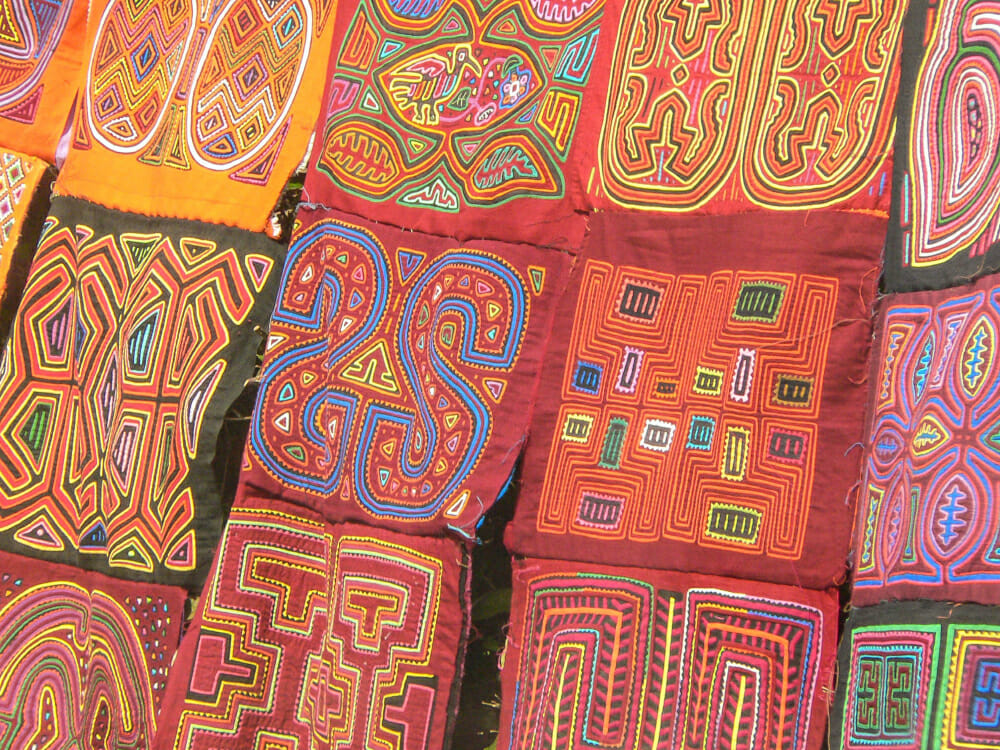
I thought I should start the new season by writing about the textiles of my home country, Panama. I haven't lived there for many years, but it is, of course, a place near and dear to my heart.
Panama is found in the Central America regions, between Colombia on the East and Costa Rica to the West. To the south lies the Pacific Ocean and to the North the Caribbean. The capital, Panama City is a modern and thriving metropolis.
In this article, I will be talking about the ancient Panama Mola which comes from one of the oldest cultures we have in this small land.
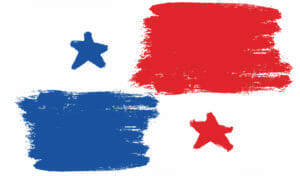

My recent New Year's message from Panama has some more info on the country if you're interested.
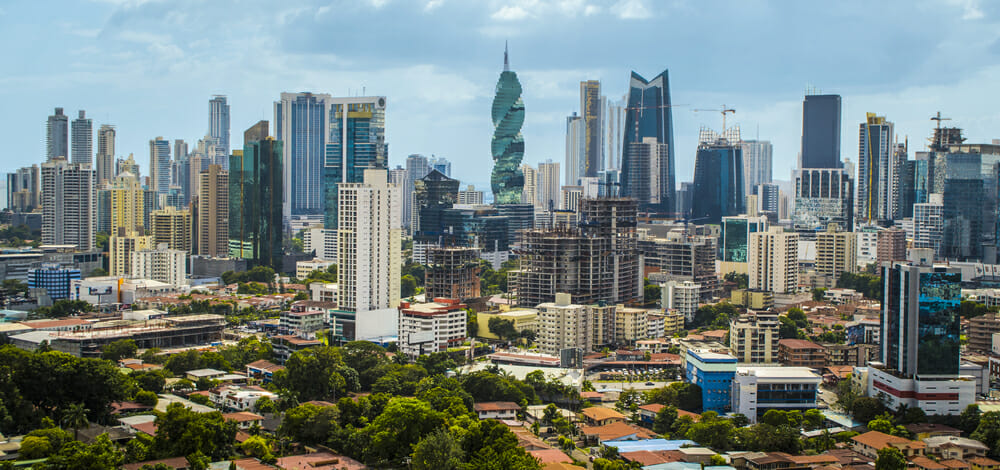

On this occasion, I am writing this from the region formerly known as “San Blas” but now called “The Guna-Yala Comarca”. It is found on the northeastern side of my beloved country of Panama, as well as the most westerly side of Colombia.
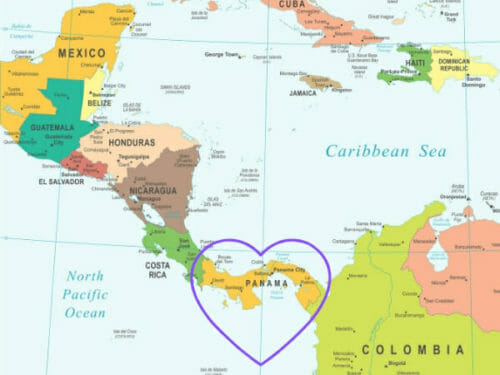

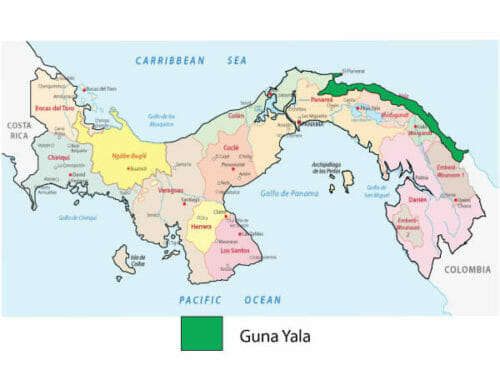

The Caribbean is a gem of a sea and one of the most romantic destinations on Earth, this is where the Guna Yala people are found.
It has been a long time since I have been in this beautiful archipelago. The last time I was here there were none but a handful of places you could stay on the whole of the 365 individual islands. Today that has changed a lot and the choices are plentiful and varied.
Back then I was practically broke, and cheap accommodations were as below…
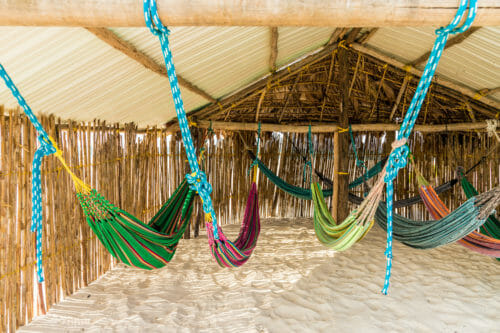

It was pleasant to see that some shacks like this one are still available.
Back then the tourist economy was in its infancy and the ability to visit the islands was heavily controlled by both the government and the Guna people themselves. I have to admit, as Panamanians, we did not appreciate the beauty of this place. It took a flood of Americans and Europeans for the locals to notice that there was no need to travel to the Virgin Islands or Cuba to find gorgeous coral reefs and white sand beaches.
Today it's a well-known region to the many yachtsmen who come from far and wide (surprisingly including many Australians) to rest for a few weeks before sailing back to Europe, down south through the Panama Canal, or up to the East coast of the USA and Canada.
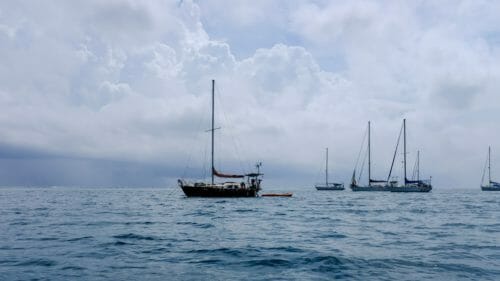

For those who approach the region by car, it is a short two and a half hours ride from Panama City to Carti Port where you can get a boat ride to the islands of your choosing.
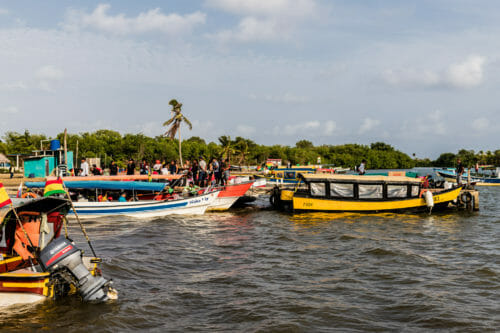

You can do about four islands in 6 hours for about USD$40.
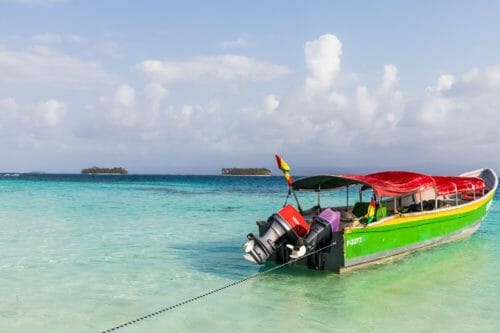

Once there you can hop around from island to island swimming and buying the local craft, the Mola.
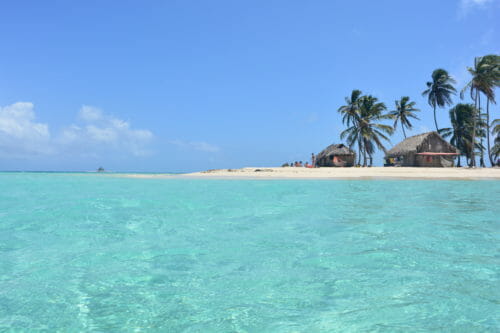

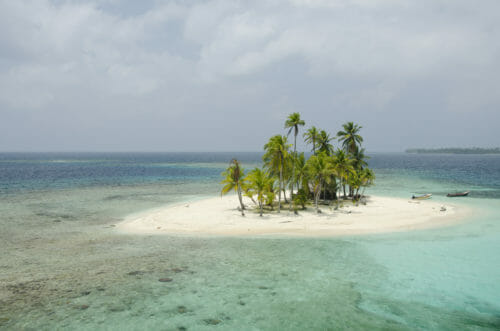

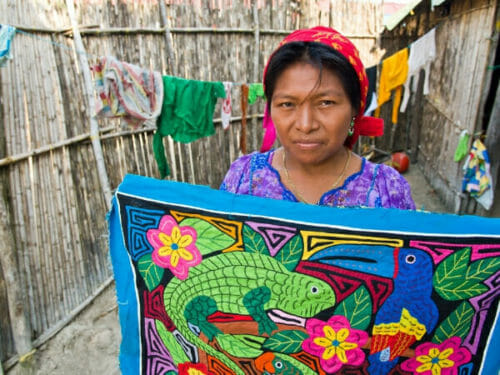

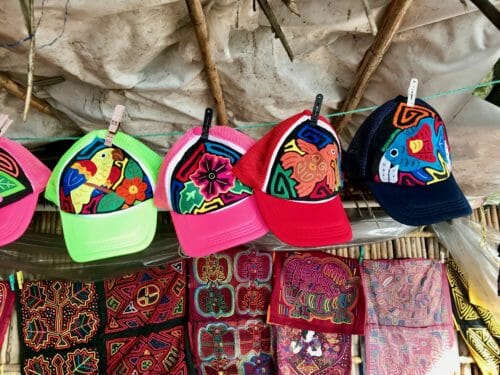

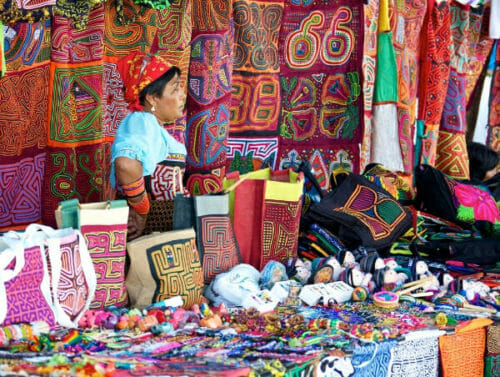

A Bit Of History On The Panama Mola
The Panama Mola has been a part of the Guna Yala tribe for over 300 years. The island of Caledonia gives us most of our clues as to its origins. We do not know for certain how the evolution of the Mola came about, but in my research, I found a source that dates all the way back to 1696 in a small town called New Eddingberg. Some in the locality know the region of Puerto Escoces (Scottish Harbour) that today appears on the map as Puerto Inabaginya. Here is where this wonderful crafting tradition seems to have originated.
Native history tells us that when Europeans arrived in the Guna Yala region they found the indigenous people wearing very little in the way of clothing with tattoos all over their bodies. The patterns were made in geometric figures with the flora and fauna of the region. These designs were later transferred onto fabric, giving birth to what we know as a Mola today.
In my travels I have found a remarkable similarity with the tribes of northern Thailand and the Mola, although made in a different technique I could not help myself to wonder, is it that the design is so simple that many people thought of it or are the Gunas somehow influenced by the much older Asian tribes or vice versa even? Are the Gunas somehow related to the Indigenous people of Northern Thailand? Have a look at the pictures below, the first two are by the Thai people from the Chiang Mai region.
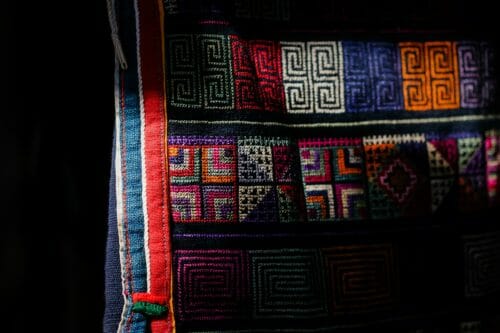

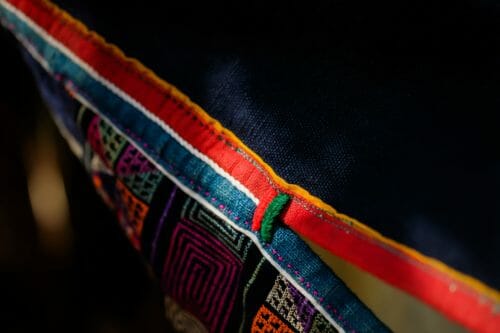

The Guna of the San Blas Islands
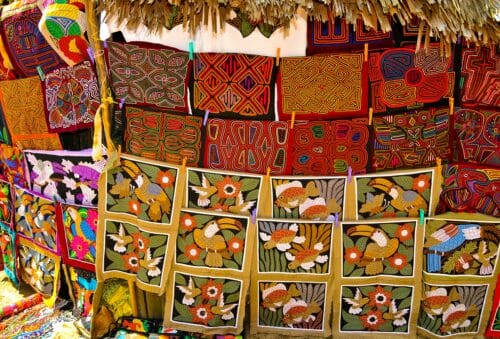

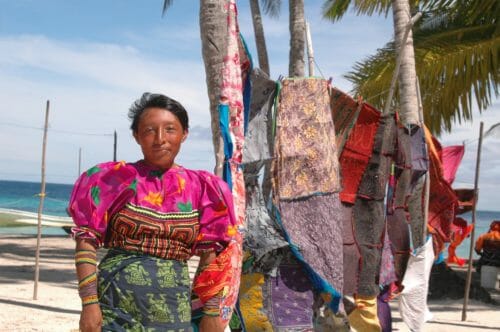

One thing is for sure is that the skirt or saron in the picture above is without a doubt a strong influence from Indonesia. It wasn't until the early 1900's that the Guna started wearing them, inspired by imported Indonesian batik fabric skirts.
If you'd like to learn more about the ancient art of batik fabric printing, don't miss this detailed article about the process.
What Are Molas?
As I have mentioned before the Gunas are also found in Colombia, below is a video beautifully put together showing how a Mola is made in far better words than I could ever explain. Hope you watch it.
Mola in the Guna language literally means clothing or shirt. It is made with 2 to 7 layers of fabrics of different colors made in a patchwork, applique technique, and embroidery. They are very much part of the vestment of the Guna woman. The best ones never get sold until a better one is made, so when you purchase a Mola you may notice the first layer looking a bit worn and bitten by the sun. Only the best quality cotton can be used since this article of clothing will sustain salt water, sun, and a rigorous washing often involving a large flat stone.
I have bought a simple design of a Panama Mola, that I will be using inside a PVC bowling bag that I think you will enjoy making for yourselves. The pattern that I will be using is the reversible crossbody bag as the bag inside.
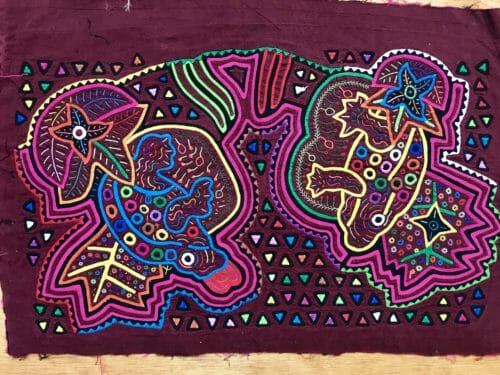

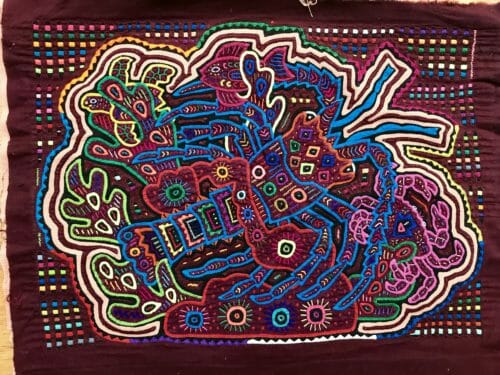

Hope you've enjoyed my little tour of this beautiful piece of heaven and this introduction to Panama Molas.
My wish for you is that one day you get to enjoy these waters as much as I have with my sister Keyla, my brother Willi, my nephew Raul David, and my daughter Sam.
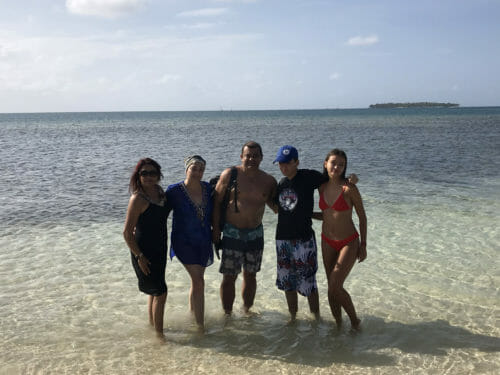

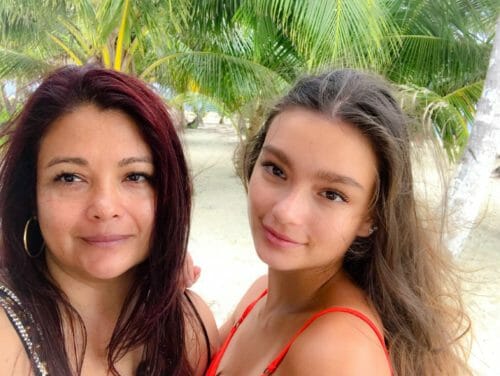

Join me next time when I will be sharing with you our national costume La Pollera which can take up to a year or more to make. Until then Happy Sewing!
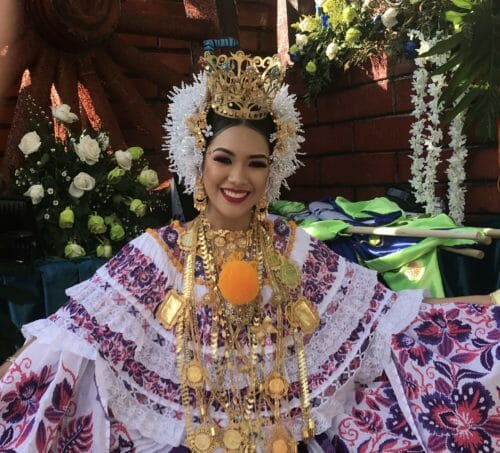

Need more inspiration? Check out more in this series.








WOW! So much work, but so beautiful!!
Thank you, Mayra! Loved the article and the photos. You are always full of inspiration! You are the best! Hugs!
I absolutely LOVED being stationed in Panama in the early to mid 90s! One of my favorite things was fabric shopping on Avenida Central! I still have some in my stash that I just couldn’t bear to cut.
I always enjoyed the trip up to El Valle and the open air market followed by the hike to the waterfall.
I have a few Mola’s that I brought home and treasure them.
I enjoyed the video. Such beautiful and detailed molas. I wondered about how the multiple colors were added in. We visited Panama in 2013. I bought 2 molas from a lady selling them by the side of the road. I don’t want to incorporate them in an article that will wear out (such as clothing or the lining of a bag as you are using.). I considered one the outside of a tote, but they also wear out. I did frame one of mine which hangs on my ‘travel’ wall where other souvenirs are displayed.
How you have blessed my day with this wonderful article. Watching the genius of her creation from good fabric and thread and her perfect hand stitches reminds me why I am working to bring care and attention to my own creating. Thank you for the care you put into creating this wonderful article!
I agree with Peggy that this is one of your best articles ever. I had the honor of visiting Panama many years ago and purchased 2 beautiful small molas that hang proudly in my home. The work is beautiful! I do so want to return to your wonderful country.
If you ever do find a site or source that sells molas directly from the makers, please do share with us! I prefer to pay people directly for their time, effort, and skill.
Thank you for sharing the video and pictures of your family! This was GREAT!
We are two of those cruisers you mentioned who ¨discovered¨ the San Blas islands about 20 years ago. Yes, the people and their islands were wonderful.
We were anchored off of a tiny one called Miriadiadup. We called it Robert´s Island because Robert(o) came out in his ulu to welcome us when we arrived. He also invited us to come see his family and what he had done to the tiny island. He had made it a tropical paradise beyond what it already was! Only 2 structures- if one can be so bold as to call bamboo and thatch a structure- but he had planted and made paths.
My husband had to go back to the boat for more money because we saw some molas his family had done and we wanted them. While waiting for him to come back I was able to communicate with the maker and asked how long it had taken to do. (The mola was about 9×12 inches and totally covered with work!) That piece took over a month…..and we paid $40 total for it , one other large one and some smaller ones!!! One could not begrudge them one penny of that!!) The craftsmanship is all the more amazing when you realize that these people had no electricity so could work only with daylight. (We did give them sewing needles as well.)
Also, truly astounding to me, many of them- who had never been to school- could speak the Guna language, of course, but also knew enough Spanish and English to deal with the “outside world”.
We have “gone to ground” in Guatemala, but still fondly remember the time we spent in those islands.
I didn’t know you were panamanian. My grandmother is from there and I have been lucky enough to visit twice. First in 1995 to visit many family I had never met before and just recently in 2019 on a mission trip for school. I loved being there in 2019, I felt like I was home. Kist apple pop is a fond memory from 1995.
Hi Angela, Indeed I am, all my family is still there. Even though I left when I was a teen it is still home for me and go back often. I love love my country.
Thank you so much for your article on molas! I’ve always loved your website but didn’t realize you were from Panama! I grew up in the Canal Zone on the Atlantic side (New Cristobal and Coco Solo). My church youth group stayed for a week on one of the islands in 1966. It was a wonderful experience. I still have my hammock that I slept in! We (the girls) slept in the chief’s hut and nearly pulled down the palm fronds as we tried swaying in them a little too much when we first tried them out! In the evening we would trade singing songs with our group and the children on the island. I can still feel the ocean breezes with our notes going up into the sky. We learned so much about our the similarities and differences in our cultures. A wonderful experience! Have some molas that were given to my parents as special presents from a cuna family that lived there and were good friends of ours.
I too, noticed similarities between molas and the Hmong applique that I saw at a quilt show in Paducah. Both so fascinating!
Hi PAM, i enjoyed your writing very much, thank you for sharing. If you can share the photos of our Molas i would be love to load them in the post.
This article has perfect timing. I had the pleasure if being a part of Harlem Fashion Week in NYC where I decided to bring my Panamanian culture to the runway. I love making bags but I do sew clothing. One of the articles if clothing I used to highlight one of the bags was your long cardigan pattern which i accented with Mola on the back panel.
I’m so proud of my heritage i had to share with the fashion world. Thanks for bringing our culture forward.
Why don’t you send me a picture girl? I would love to feature it here, with full credits of course.
Hola doña Mayra
I sentido the pictures to your Mayra email.
Thanks a million
Thank you karen will load them ASAP.
Love your article on the molas. One of the stops on a cruise we took through the Panama Canal was the island of the Kuna indians. They were little people, the women didn’t speak, sat working on their molas, but they watched us point and we were able to buy embroidery work, patches and fabric (narrow) by pointing. Boys would dive and bring up large conk shells – we bought one for $1. No electricity but they had a generator for the one TV they had on their little island. I used two pieces we bought to make two pillow covers for our sofa and always get comments.
Hi Ruth, Sounds like you had a good time 🙂
Beautiful article. I am Panamenian and for me is so wonderful that someone talk about our sewing culture.. The Mola, La pollera, los congos, parumas, naguas and chaquiras. A lot of sewing hertirage to share with the world, Thanks for show and taugh of our contry.
Indeed Jackie, there is so much to share.
Very interesting! I enjoyed all of it. It is a beautiful country and it would be such a pleasure to visit and see the fabrics and how they put them together! Thanks for sharing
It is my absolute pleasure, I hope you come to Panama.
Oh my gracious—what a beautiful and educational article! I truly love your articles about the history and origin of fabric, and arts and crafts. You are truly the epitome of this wonderful country of Panama! I have never been to Panama, but I have a wonderful friend from Panama. When we first met, we felt as if we had known each our whole life. She has a beautiful and gentle spirit. Even though I have never met you, through your articles, I Feel you are the same. Thank you so much for sharing your history, your teachings, and yourself. I am truly a fan.
Not sure where you are Yvette for one day we could meet. Looking forward!
I am in Los Angeles, CA and I would love to meet you one day. Anyplace is but a plane ride away?
Indeed Ivette, next time in LA, (it has been a while for me) will have coffee 😉
How cool to find out that you are from Panama, I thought you were Asian and had gone back home. I have been living in Panama for 11 years and love it! Thank you for sharing your information and letting other people know how cool (warm) and diverse this country is. It is the Best!
I am happy that you are happy in this tiny land. Hope one day we could meet! yes I am Panamanian, and as such have one of those faces, very mixed 🙂
Thank you for sharing the story of the molas! I lived in Panama for 5 years during the 1970s. This reminded me of the wonderful times there. We actually went by boat to the San Blas islands. We camped for a week on an uninhabited island. We took everything we needed with us. We also went island hopping along with underwater reef exploring. Watching the video brought back memories of the native ladies showing us how to make our own molas. We have many molas in our family as they are treasured keepsakes. Some day I might go back. I’m not sure if I want to see how things are now, when I loved home simple and un-commercialized the country was back then. Panama was not a tourist attraction like it is now. Thank you so much for sharing this story.
I know what you mean, I have a hard time returning to a place I once lived, we romanticise our memories and with time we look at the country with kind eyes. I certainly don’t care for the traffic jams and the rudeness of people when driving, but at least in the island you can take a step back into a time long past. The GUnas today have mobile phone but dress and live the same way. you can still recreate your experience. Hope you come back.
I found out last year that my paternal side of my family came from Panama. I look forward to learning more about this country. Thanks
Welcome home Beverly!
Your best article! I so enjoy learning about your country. I’ve always liked the molas and have a collection. Those owl ones are great. One of my favorites in my collection is of a rooster. I would like more ideas on how to use and display them. So far I’ve appliquéd them to the back of jackets and bags. Thanks for such an informative blog. Someday I would love to visit Panama.
Thank you Peggy and I hope you do. I used them as placemats, and framed on the walls.
When my younger brother was stationed in Panama he sent me a Mola I still have it to this day but my brother has since passed away but when I look at the Mola I think of him and all he thought of Panama and the people there he Loved it and the people. So thank you for sharing this history.
Yes, Debbie, I am sure he was treated well. Back them when the Americans were stationed in Panama were seen as superheroes. They gave stability and made the Canal so we owe a lot to your brother and those before him.
I so appreciate this article. I worked on ships for ten years, and during a cruise through the Panama Canal was introduced to the incredible mola. I purchased two, but often wished I’d purchased more. I never did figure out how to make one.
thank you so much for sharing Panama with us.
will you teach us how to make a simple Mola?
I will do my best, I am going to take a class them I will share it with you.
Thank you so much for sharing this!
it was my pleasure.
This was a delightful change from just reading about patterns (although I do love your patterns! Keep them coming!) and the photos were wonderful. Makes me want to visit Panama! But most of all, that video is jaw-dropping. To see all the care and work and skill that goes into these works of art is a revelation. Thank you! And I must say, I see in the photos that your daughter is a stunning beauty–maybe because she looks so much like you! She’s lucky to have a talented mother to learn from. I appreciate all you share with us “sewists.” I am always glad to see your latest post.
I enjoyed reading your information and watching the video of making the mola.
It was interesting where you said the locals had not appreciated the beauty of their location and it took floods of tourists for them to become aware. So true for many things. The mola is beautiful and so colourful. The women and girls are talented, patient and have a creative eye, re-creating the local beauty in their clothing.
Thank you for providing this information about the mola and the people who make them, and the maps that show the location. Video was also interesting. I have always been impressed with the work that goes into making a mola–all the pre-planning, intricate details, and tiny stitching, and then the finished art work.
So beautiful!
I enjoyed this video and your article about the Molas and the islands. I am intrigued by the beauty and richness of their lives there. Beautiful sewing, beautiful colors and oh how wonderful Gloria’s art is!
Indeed, it is!
What a lovely article! My father was stationed in the Canal Zone in the late 70s. As an Army brat, and later an active duty soldier and then an army wife, Panamá remains my favorite place I’ve ever lived. I have several molas, and love them for their beauty and for the happy memories they bring to mind. Thank you for sharing this beautiful art form, and I very much look forward to reading about Las Polleras!
HI Kate, on behalf of the Panamanians thank you for remembering us with kindness.
Thanks for a very informative article. The Molas are beautiful.
My pleasure Joy, yes they are beautiful.
Thanks! I love the mola and have several in my fiber collection. My plan is to try to make one of my own. The vides was helpful.
Love to have a peek at your fiber collection 🙂
We have a Mola in a frame that we purchased when we were in Panama. They are beautiful. We also have a picture of my husband with the woman in the La Pollera. We went to a restaurant in Panama that featured traditional dance and my husband was asked up on stage to dance with her. Great memories!
Mayra, thank you for this wonderful article about Panama, the Guna people, and the mola. I love the photos of you and your family! I have a tote bag with a mola on one sidend that I purchased in Costa Rica that I’ve been using for decades. It is an astonishingly beautiful for of art.
Lovely article, so interesting. Thank you for sharing your love with us.
Thank you so much for a very informative article about the Molas and history of the region. The inclusion of the world and county map helped me locate the region. Beautiful pictures and stories.
Awwww! Panama our country. The mola is known internationally, and only the San Blass natives know how to do that particular time consuming hand applique technique. There are so many beautiful designs. As a kid growing up in Panama I sorry to say that the mola was not appreciated. Today with technology and the magic of Google Panamanians have finally learn to appreciate the mola and what it represent. Yes, Panama is a beautiful country to visit and experience. And I would my comment by saying Viva Panama! Thanks for sharing.
Muy cierto Mariela, y si Que viva Panamá!
Thank you so much for this article and the video!! I have 2 molas (I wish I could attach photos). I think mine came from Colombia since my family and I lived there from 1968 – 1971. My mother has two or three which I will be bringing to my home (she is, sadly, in a nursing home), but she always had a wonderful eye for art.
Your article gave me the confidence to take one of the molas (that was in a frame, and all bunched up in the frame) out of the frame and wash it. They are not as delicate as they appear! I have always loved them – the colors, the obvious craftsmanship. I feel bad that they have to sell them so cheap because people do not appreciate the work that goes into them; so sad.
HI Terry, thank you for your appreciation of the art. We need to help change this attitude so please share the article. Do send me your pictures and I will add them to article. I am interested because they are old and have been in your house for half a century. They are priceless.
I think this video about the sewing of molas is absolutely fascinating. I would enjoy seeing more from this beautiful and colorful craft. I can’t imagine making one, but it would be fun to try. Thank you for sharing this.
It was my pleasure!
The article was very interesting but the video and the finished Mola were AMAZING! It was like stepping back in time to the beginning of their culture and witnessing first hand the birth of a beautiful tradition. I’d love to buy a piece of “Mola art” for my home. Do they have an online shop? The format and the woman who did the demonstration were wonderful. Just a suggestion, if you truly want to get a clue as to who may have originated similar art or where their ancestors may have came from, I’d suggest someone from there take an Ancestry DNA test. I’m African American and Ancestry has really opened up my past to me. I’ve connected to wonderful matches in Australia from my “European” side. Thank you so much for sharing this art form. It truly is beautiful!
You can find molas on etsy.com
Yes, I have a subscription
Hi Mary, the best way to buy a mola is from the Guna themselves. You can buy in a few shops around the city and perhaps online but this people are only the intermediary and pay the very little to the artists. As far as I know The Guna do not have an online shop yet.
Thank you for sharing. It was lovely “traveling” with you. A person can’t know enough about other cultures and you helped put a face, beauty and history to your country.
Such a lovely comment, I love this tiny country and with all its shortcoming and hardship still is a beautiful country.
I enjoyed your article about the Mola and the history of these peoples. With our modern culture, and always being in a hurry, we lose a lot of the old ways and the culture that goes along with them. It’s good to know the history of our beginnings and to hold on to the old ways. They had skills that are not found now and we don’t know how they did what they did without all of the modern tools. As I’ve gotten older, I love history and learning what evolved to become what we use now. Most of the time we think if it’s not modern, it’s not valuable and we are wrong in that assumption. Thank you for your article, history and letting us know a bit about your land
HI Patricia, it is I who must thank you for taking the time to read, taking and interest in this lovely art and sending your comment. We are a tiny land but ours is a very rich history.